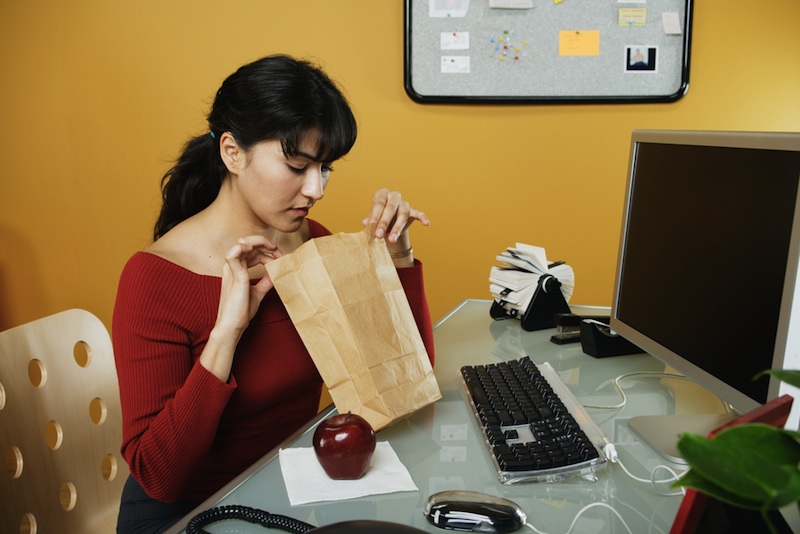What Happened to the Lunch Break?

When's the last time you left your desk and took a real lunch break?
For many workers, the answer is "not recently," a trend driven by a bad economy and high workplace expectations, researchers say. A recent McDonald's ad campaign even took advantage of lunch break dissatisfaction with a series of commercials telling workers, "It's your lunch. Take it."
Although there are no national statistics on lunch breaks, small-scale surveys find that up to two-thirds of workers skip lunch or eat lunch at their desks.
Kristen Pierce, a former employee of a large tech company in the Washington, D.C., area, was one of those deskbound lunchers.
"We generally worked through lunch or ate during a conference meeting," Pierce, now a university marketing assistant in Michigan, told LiveScience. "It was definitely an atmosphere where if somebody needed you and you were at lunch, that would be taken as a very negative thing — even if it was a completely normal lunch break and you were two rooms away."
Lost lunch breaks
Skipped lunch breaks are a growing trend, said Danielle Hartmann, the director for corporate partnerships at Boston College's Center for Work & Family.
Get the world’s most fascinating discoveries delivered straight to your inbox.
"I think the expectation is that more people are expected to work more with less," Hartmann told LiveScience. "Workloads have been exceptionally high and people don't feel like they can take the time to eat." [7 Perfect Survival Foods]
Should time off for lunch be mandatory?
"Many of the organizations have been downsized, and as a result, folks have significantly more responsibility," said Ron Sims, a vice president at Right Management. "They don't want to be seen as somebody who is not fully contributing."
That's an urge that might seem productive but actually burns you in the long run, said Nancy Rothbard, a professor of management at the Wharton School of business at the University of Pennsylvania.
"There is support for this idea that taking these breaks can actually help you do better and focus better on your work and have new ideas," Rothbard told LiveScience.
Benefits of breaks
Research on call-center workers and software developers, two very different job types, has found benefits to taking breaks throughout the day, Rothbard said. What you do on these breaks mattered, she added. Anything replenishing, such as relaxing or socializing (if enjoyable), tends to lend people renewed vigor for the post-break stretch. Running around trying to cram in extra errands or chores, on the other hand, does little for afternoon productivity. [7 Things That Will Make You Happy]
In one 2010 study published in the Journal of Occupational Health Psychology, researchers found that assigning call-center workers to 20-minute "progressive relaxation" breaks, in which they participated in meditation-like activities, removed feelings of strain in the afternoon, compared with 20-minute breaks where people engaged in small talk with co-workers.
The benefits of breaks range from ergonomic (getting out of your chair occasionally is good for the body) to professional (chatting with co-workers at lunch can spark new camaraderie and collaborations), Boston College's Hartmann said.
Taking back lunch
There are no federal requirements for lunch breaks, though many states have laws that require meal breaks for hourly workers. Many salaried employees are not covered by these laws.
Nevertheless, some companies are seeing the benefit of encouraging lunch breaks, Hartmann said. She works with several companies that have started encouraging employees to hit the dining hall or the fitness center during lunch hour as a way to promote health and creativity.
These initiatives are sorely needed, according to Sims. Employees in North America are less engaged in their work than they have been in years, according to Right Management surveys, he said. While an engaged employee is willing to go the extra mile, Sims said, disengaged employees are just trying to get through the day.
"You may have their activity, you may have their feet, but you don't have their hearts and minds," Sims said. [Slacker Staffers: Workplace Disengagement (Infographic)]
Flexibility may be key for employers hoping to cultivate satisfied and productive workers. Former tech employee Pierce now works at an office with a mandatory hour lunch break. She'd prefer to work through lunch and use that hour to go home early.
"I'm a big fan of flex hours and adapting to people's individual work styles," Pierce said. At one of her old companies, she said, the bosses and co-workers took a live-and-let-live approach to the lunch hour.
"If you wanted to work through it nobody interfered," she said. "On the other hand, if you wanted to go out and spend your lunch hour in the sun folding paper planes, nobody thought less of you for it, and that was great."
Follow Stephanie Pappas on Twitter @sipappas or LiveScience @livescience. We're also on Facebook & Google+.

Stephanie Pappas is a contributing writer for Live Science, covering topics ranging from geoscience to archaeology to the human brain and behavior. She was previously a senior writer for Live Science but is now a freelancer based in Denver, Colorado, and regularly contributes to Scientific American and The Monitor, the monthly magazine of the American Psychological Association. Stephanie received a bachelor's degree in psychology from the University of South Carolina and a graduate certificate in science communication from the University of California, Santa Cruz.
